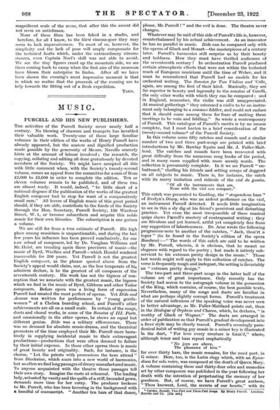THE CINEMA.
THE MOUNT EVEREST EXPEDITION AT THE PHILHARMONIC HALL.
CArrAnkr J. B. NOEL tells the first part of the story of the Everest Expedition, of which he was a distinguished member. He began his lecture on the evening on which I attended by what he seemed to consider a confession—that the ascent of Mount Everest was of no particular use, and had been under- taken . . . in fine, it had been undertaken. Thus he gave to his interesting discourse and his wonderful films and photographs exactly the right atmosphere of adventure and romance, a romance of the spirit as much as of the body. What, wa at once begin to ask ourselves, was the spirit which animated the bodies of these men—so strongly that it drove them almost to the top of the highest mountain in the world ? Through the scorching cold of blizzards it sent them across crevasses, up ice-cliffs, through gigantic labyrinths of ice blocks, toiling like tiny flies up the wall of the world—a painful way where fivo breaths were needed to give a man strength to take a single step. The prime joke of the expedition seems to have been to attribute this force to a religion. The climbers were all entertained at the Rongbuk Monastery—the highest in the world. At the head of this house is a Lama, who is especially saered as he is held to be an incarnation of the Buddha. Pilgrims come from all over Tibet to visit the monastery and to see there the celebration of elaborate ritual dances, which are performed by the monks. The Expedition was anxious to enlist the sympathy of the Lama, and he was therefore told that it was the religion of the Royal Geographical Society to visit all the places in the world, and of the Alpine Club to get as near as possible to heaven. If it were found possible to ascend the mountain, then the men who helped or took part in the ascent would have acquired great merit, as they would have got nearer to heaven than any man born. The Lama, being a wise man, not easily deceived, saw that such was the religion of the Expedition, and he blessed their- Tibetan bearers, touching them each on the head with a sacred amulet. Of this company of bearers seven perished in an avalanche in the climb, which had become a pilgrimage. There arc several wonderful films showing the audience which the devotees of the Expedi- tion had with the chief Lama. The rude dignity of the ceremony and the chief figure's bearing are impressive. He is a man of a very curious cast of countenance, not at all Mongolian, but with a ratherlong, irregular nose and straight- set eyes. It is a face which Hogarth would have painted to perfection, a face not unlike Mr. Frederic Austin as " Peachum." It seems strange to think that the man behind such eyes could tell us what it feels like to be worshipped as a god. Simple imposture and self-seeking will not account for such a manin such a position, we feel, as we look at his moving shadow. Some belief or conviction lies behind the quiet dignity of those shrewd, melancholy eyes. The " devil dancing " and the temple music which accompanies it are both of great interest. The music was noted down by Mr. T. H. Somervell, and in this scene was as little arranged and adapted as possible. Of its nature I am not competent to speak, but to me it consists mainly of long trumpet blasts and rolling drumbeats, the whole impression being one of a stirring and melancholy wildness perfectly in keeping with the theme of the dances and the scene.
The object of these dances is said to be that of accus- toming the mind to the sights and sounds which the soul will encounter after death. All the dancers are masked and the dances seem mimetic in character. Such beings as grave- yard ghouls and personified passions are represented. The figure which represented Anger, and the impassive but malig- nant little creatures who were the " Minor Ills " and " Small Discomforts," were an admirable expression of universal experiences. In these scenes ft would have been very inter- esting to have from the lecturer some hints as to the colour. The robes and jewels appeared to be magnificent. Many of the masks seemed to have lights upon them as if they were gilded. Some information on this head would greatly help the audience's imagination. This interlude in a rude and exotic community lent great variety to the film, and it is a proof of the glamour of the feats of endurance and of the
magnificent scale of the scene, that after this the ascent did not seem an anticlimax.
None of these films has been faked in a studio, and herefore, for all I know, to the blasi cinema-goer they may seem to lack impressiveness. To most of us, however, the simplicity and the lack of pose will amply compensate for the technical faults which, under the extraordinary circum- stances, even Captain Noel's skill was not able to avoid. We see the tiny figures crawl up the mountain side, we see them coming back to camp when the first airs of the monsoon have blown their enterprise to limbo. After all we have been shown the evening's most impressive moment is that in which we realize that the proceeds of the evening are to help towards the fitting out of a fresh expedition.
TARN.











































 Previous page
Previous page